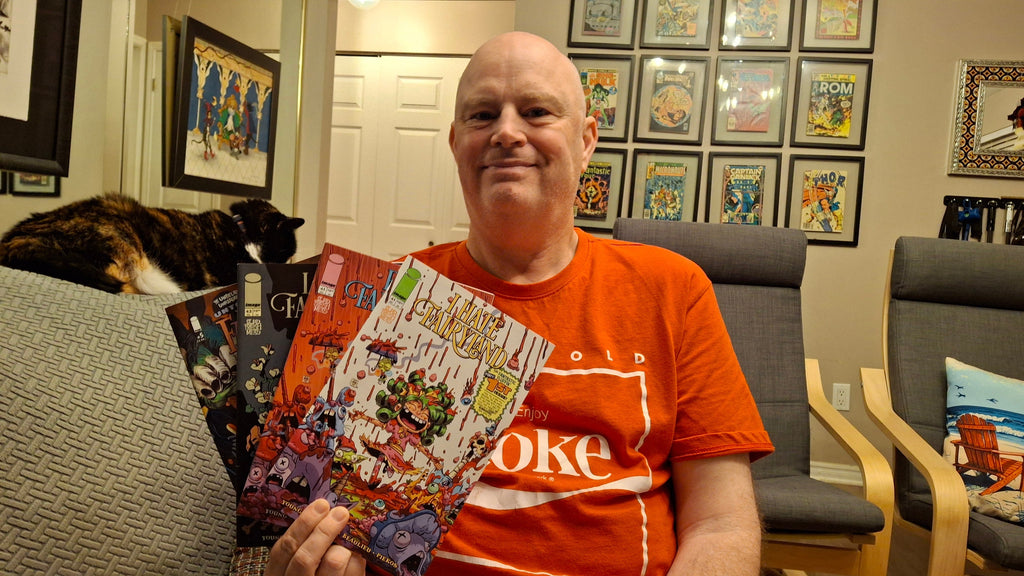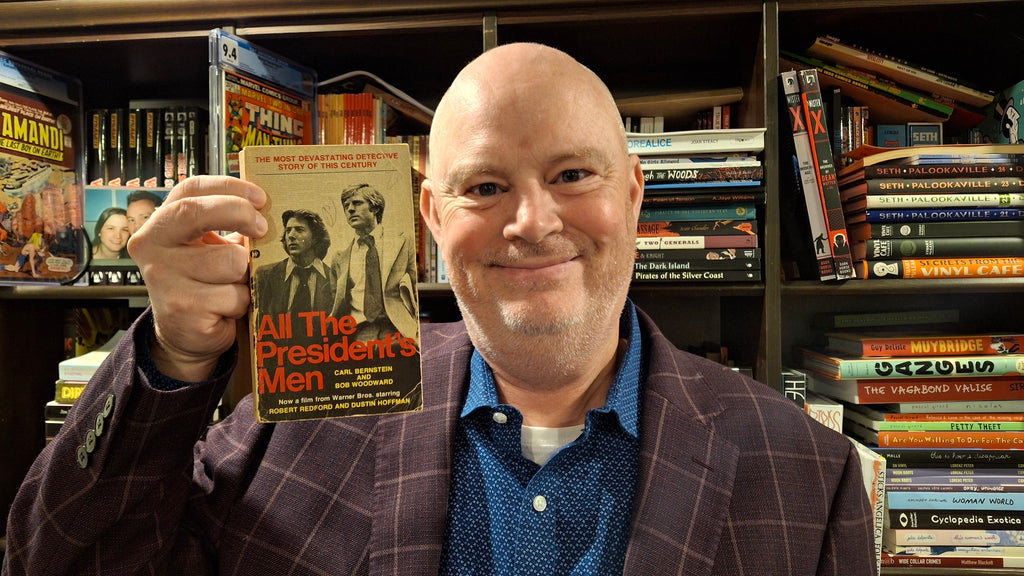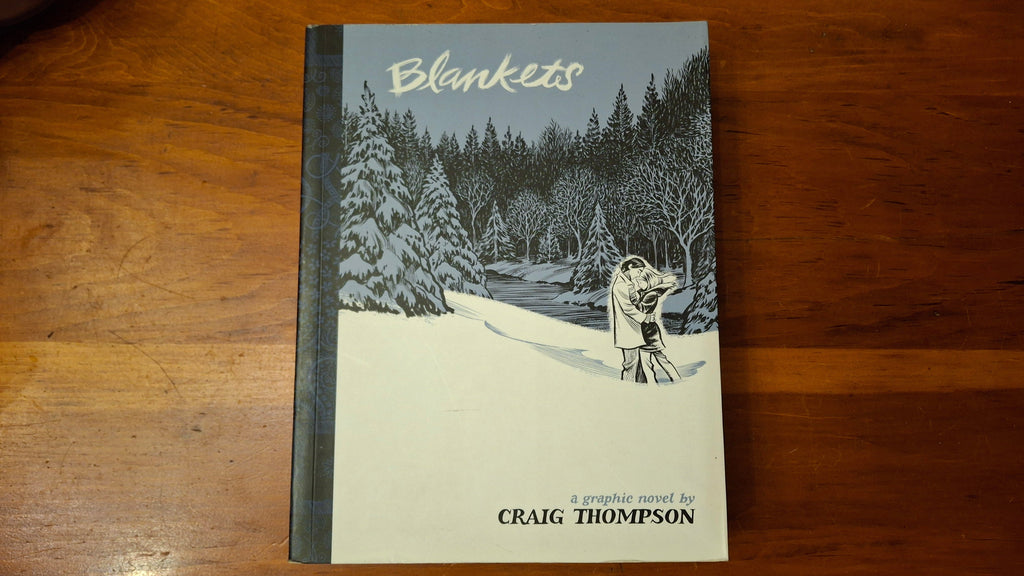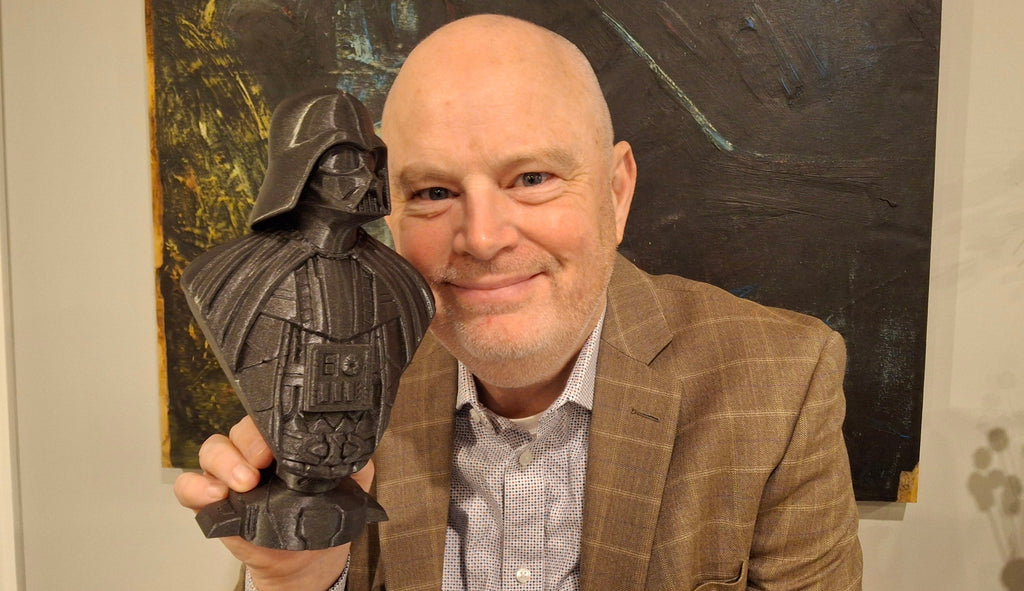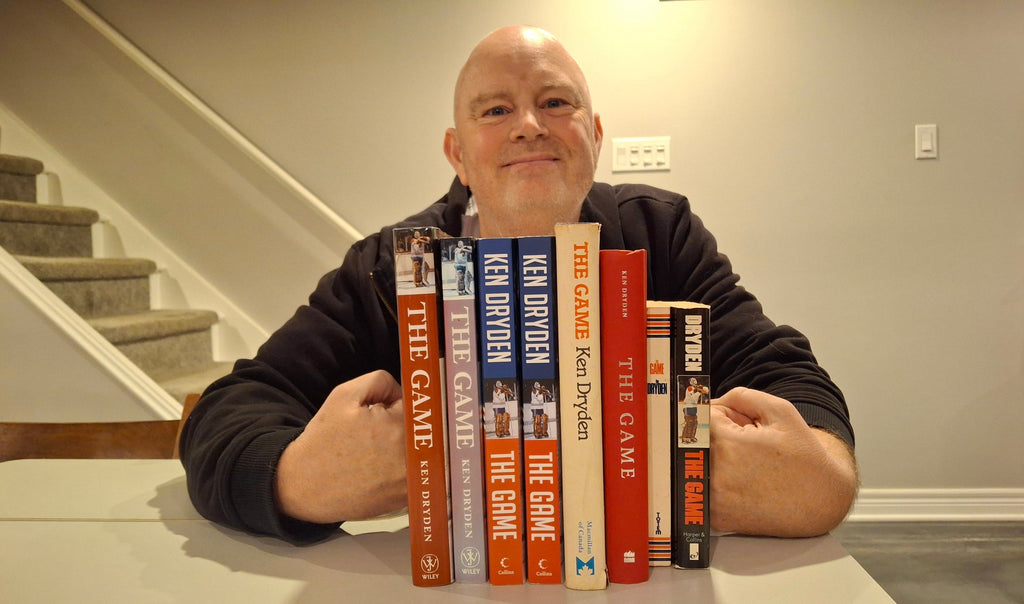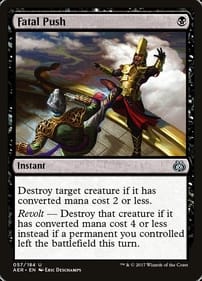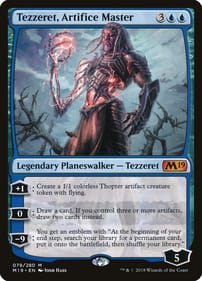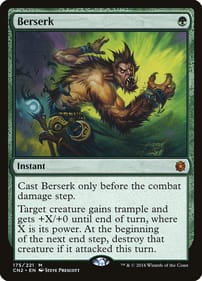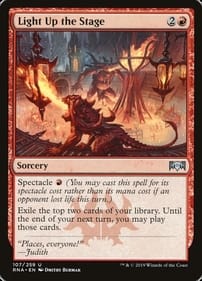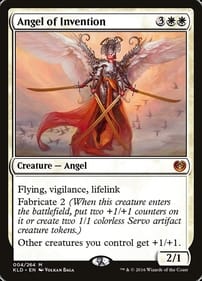Derek Laufman Takes on Fairyland
By Dan Brown Derek Laufman’s work is, above all else, fun. The Byron-based comic creator took over as the artist for the Image series I Hate Fairyland with its 41st issue. Created and written by Skottie Young, the cartoony comic stars Gert – a green-haired, foul-mouthed moppet – who yearns to return to the real world. And no one is going to get in her way. I don’t know a lot about I Hate Fairyland so I recently checked out issues 41 and 42, plus an anthology comic (Untold Tales of Fairyland No. 5) that includes a Laufman-created story. I am now of the opinion that this series is the perfect showcase for his style of art. Laufman does all-ages work. He does more adult-oriented work. And I Hate Fairyland combines both strands in one unserious, fantastical, outrageous platform. With a yellow ribbon in her curls, Gert may appear to be a cute child. But she knows how to swing the double-bladed ax she carries around, the edges of which always seem to be coated in green ichor. There is something heedless, unhinged, and funny about Laufman’s outlandish characters. Gert is always accompanied on her adventures by Larry, the wide-eyed bug who is her Jiminy Cricket figure. In a move that could never happen in a modern Marvel Comic, Laufman depicts Larry with a stogie in his mouth – heaven forfend that comic fans should be able to look at pictures of tobacco products. There’s also a tattooed pink walrus who tends bar at a dragon-themed pub, a sentient golden harp that talks like a demented cherub, and a living forest with two eyes and a mouth on each tree trunk. Shades of John Byrne, who is famous for inserting cameos of himself into the comics he draws, there’s even a bearded illustrator in one bar scene who may just be Laufman himself. Gert is always drooling. Her nose is perpetually dripping. And in one scene, she identifies the steps of an invisible bridge by barfing on each one to reveal the path over a chasm. Slmon! Slurry! Slart! Sleating! Stoo! These are the sound effects as Gert stuffs her face before hurling. “That was an epic regurgitation,” she tells her sidekick with satisfaction after they have crossed safely to the other side. I Hate Fairyland No. 42 introduces a new character into the mix – the Hellicorn, who is an homage to Mike Mignola’s demonic Hellboy. Clad in a trenchcoat but no shirt, armed to the teeth, and sporting a purple pompadour, the Hellicorn journeys through a land populated by fairy-tale characters like the Old Woman in the Shoe, wreaking havoc as he shoots mud zombies, then battles with Mary (whose Little Lamb is not so small) before passing by the corpses of Jack and Jill. And yes, clenched between the brooding Hellicorn’s teeth is – a fat cigar. For more of Laufman’s art, check out his all-ages books like Bot 9 and The Witch of Wickerson, suitable reading for children. His dungeon-plundering title for mature readers is Crimson Fall. He has also done work for DC and Marvel, as well as such toy companies as Hasbro and Mattel. Laufman can tell you all about it in person when he appears on Nov. 2 at this year’s edition of Forest City Comicon, taking place at the Lamplighter Inn. I may just be first in line! Dan Brown has covered pop culture for more than 33 years as a journalist and also moderates L.A. Mood’s monthly graphic-novel group.
All the President's Men continues to Inspire
By Dan Brown After Robert Redford died on Sept. 16, the accolades came pouring in. He was remembered as a legendary actor, director, advocate for the environment, and founder of the Sundance Film Festival. What the rest of the world might not know is Redford also has a special place in the hearts of journalists of my generation. Even if you’re not a journo, you likely know Redford played real-life Washington Post reporter Bob Woodward to Dustin Hoffman’s Carl Bernstein in the 1976 feature-film adaptation of All the President’s Men, the duo’s account of their Watergate reporting, which ultimately led to Richard Nixon resigning as U.S. President. Redford fought to get the motion picture made. People told him Watergate was old news, that the country needed to move on in the aftermath of its long national nightmare, that a story about two journalists doing long hours of research wouldn’t play well on the big screen. But it did work, and All the President’s Men – the movie – is still inspiring media professionals all these decades later. It’s a journalism classic, and a perfect example of a 1970s paranoid thriller. I often turn to All the President’s Men – the book – to help inspire the young journalists I mentor at the Western Gazette, and teach at Western University. The worn paperback copy I have on my bookshelf has a picture of Redford and Hoffman on it, not the less photogenic Woodward and Bernstein. I like to remind my mentees and students that the two reporters, both in their 20s, weren’t all that much older than them when the Post helped to bring down Nixon. The book is a testament to the power of old-fashioned shoe-leather journalism. It wasn’t AI that helped the pair to trace the Watergate burglary back to the Oval Office, nor was it the internet. How primitive were the reporting tools back in the early 1970s? Heck, Woodward and Bernstein didn’t even have voicemail, it being the era of rotary telephones. What they did have was time, the most valuable resource to a journalist. Neither one of them had much of a social life, so their competitive advantage was that they came into the newsroom on weekends and stayed late in the evenings. I also remind my young charges how Woodward and Bernstein made mistake after mistake. They were swimming in uncharted waters, so the journalism textbooks of the day were no use to them. Luckily for America, they were smart enough to learn from their mistakes. They did have institutional support in the form of top Post editor Ben Bradlee. When the paper was attacked by the White House, it was Bradlee who crafted the Post’s response: “We stand by our story.” All journalists should be so lucky to have that level of confidence from their boss over a prolonged period – keep in mind Nixon didn’t quit until two years after Watergate, when the Republican brain trust on Capitol Hill told him he wouldn’t survive an impeachment conviction vote in the Senate. All the President’s Men belongs in the film canon along with the likes of the Parallax View, Network and Capricorn One. For a country that was so disillusioned, it provided a tonic by showing two regular guys who were determined to get the truth about Watergate out to the masses. Judging by recent events south of the border, it’s a message that is as crucial now as it was then. Other journalism movies I recommend: The Paper, Spotlight, Shattered Glass, Broadcast News, The Killing Fields, The Insider, Citizen Kane, Salvador, Frost/Nixon, Almost Famous, and Anchorman. Would love to hear about your own favourites in the comment box below. Dan Brown has covered pop culture for more than 33 years as a journalist and also moderates L.A. Mood’s monthly graphic-novel group.
It’s Easy To Beat Up On Graphic Novels
By Dan Brown Who will stand up for comic books? I’m thinking about this question after Alberta Premier Danielle Smith ordered school libraries in that province to pull books with pictures of “pornography” in them (her word). “What we are trying to remove are graphic images that young children should not be having a look at,” Smith added after the original ministerial order from her government blew up in her face. From what I’ve read, there are four specific graphic novels that have raised Smith’s ire: Craig Thompson’s Blankets, Alison Bechdel’s Fun Home, Mike Curao’s Flamer, and Maia Kobabe’s Gender Queer. I’ve read only one of those books, Blankets, and I recall it as an earnest attempt by Thompson to describe his struggles growing up in a fundamentalist Christian home. Perhaps Smith doesn’t like it because – spoiler warning – it ends with Thompson leaving the church. The other three books have one thing in common: The sex they depict isn’t between a man and a woman, but same-sex partners. Of course, Smith isn’t the first person to pick on comic books. Hating on comics is a tradition that goes back decades, extending back to the era when the audience for comics actually was children. These days, the typical Marvel or DC reader is a dude in his forties or fifties. You may have heard of Fredric Wertham, the notorious crank psychiatrist who campaigned against comics in the 1950s. It’s hard to believe now, but there were actual Congressional hearings in the U.S. into how comics were unfit for America’s kids. There were also comic-book burnings. Among his complaints with comics was Wertham’s feeling they were too violent, thus making young kids into juvenile delinquents. He also thought they turned straight kids into gay ones. Wertham hinted there was something going on between Batman and Robin between the panels, and even wrote a book detailing his research, which was thoroughly debunked years ago. But Seduction of the Innocent did have a major impact, with the comic industry opting for self-censorship in the form of the Comics Code, which lasted until 2011. How ridiculous was the self-censorship regime? A comic was once rejected by the Comics Code Authority censor on the basis of writer Marv Wolfman’s last name being in the credits, since the Code forbade mentions of the occult like, you know, wolfmen. Will anyone stand up for comics in Alberta this time around? I don’t know. I do know it’s easy to score political points by attacking comics and graphic novels, since there are so few organizations set up to champion them, at least in Canada. We do not have an equivalent to the U.S. Comic Book Legal Defense Fund, which supports creators, retailers, and educators. That said, I was encouraged to see that the Toronto Comics Art Festival spoke out against Smith’s lunacy. “We cannot stand by while governments and school boards strip these stories from bookshelves,” the organization’s board said in a statement early this month. “This fight is about the freedom to read. It’s about whose stories we allow to be told, and whose stories we try to silence.” I’m hoping others will follow TCAF’s example. At a time when there is a global information source containing easy access to all kinds of actual hardcore pornography, it seems odd to single out graphic novels that young Albertans likely aren’t all that interested in reading in the first place. They’d rather be playing on their phones. Dan Brown has covered pop culture for more than 33 years as a journalist and also moderates L.A. Mood’s monthly graphic-novel group.
A New Voice for Darth Vader?
By Dan Brown James Earl Jones died one year ago this month. A true renaissance man, he is one of the few entertainers to be awarded an Emmy, a Grammy, an Oscar and a Tony. That puts him in rare company. But to an entire generation, he is known for a single role, and he didn’t even play the whole character – Jones supplied just the vocal cords. If lines like, “No, I am your father,” and “I find your lack of faith disturbing,” and “Search your feelings” mean anything to you, then you know I’m referring to Darth Vader – the bad guy from the original Star Wars trilogy (by original I mean those three films appeared in movie theatres before the other trilogies and spinoffs). Jones wasn’t in the black suit, but his deep, booming baritone arguably did more to create the air of evil and menace that Vader exuded than David Prowse’s bodily presence. Now seems like the right time to discuss Jones’s future as Vader’s mouthpiece. Even though the character died in 1983’s Return of the Jedi, many Vader stories have been told since then and the baddie’s popularity has only grown. I know what you’re thinking: Didn’t Jones sign a deal so his voice could still be used to bring Vader to life, even after the actor had passed? According to sources like Deadline, yes, such a deal was hammered out a couple years before his death. But that doesn’t mean Lucasfilm is contractually obliged to do so. They could re-cast. In fact, there might even be an advantage to doing so. If I was in charge of finding a new sound for the role, my short list of performers would contain names like Ving Rhames (who is already the voice of Arby’s), Dennis Haysbert (who appears in commercials for Allstate Insurance), and Keith David (who has done a ton of voice roles and commercials). Star Wars director George Lucas had originally kicked around the idea of hiring Orson Welles for his space-opera villain, but decided the vocals would sound too familiar – Welles was the person who narrated a Martian invasion of Earth on the radio in 1938, after all. I admit re-casting comes with a substantial risk. Every fan who hears a different actor’s voice coming from the black mask would be comparing it to Jones. Star Wars fans can be tradition-minded folks who don’t like anything that strays too far from the blueprint laid down by Lucas before he sold his empire to Disney. The lure of using an actual person for Vader, on the other hand, is that it would be a reminder that Vader is somewhat human, and was redeemed in the end by his son, Luke Skywalker. What seems more likely is any future Star Wars production team will plunder the library of existing takes from Jones and use some sort of technical trickery. And I get how that would be an appropriate way to go for a character who is, according to Obi-Wan Kenobi, “more machine than man.” There’s something fitting about using technology to portray a cyborg, so AI may in fact be the route they choose. And yes, this is what the producers of the Kenobi series did in 2022, with Jones’s voice failing as he neared the end of his life. One thing we know for sure: Given movies like Rogue One and TV shows like Kenobi, we haven’t heard the last from Darth Vader. Dan Brown has covered pop culture for more than 33 years as a journalist and also moderates L.A. Mood’s monthly graphic-novel group.
Comic Cover Version an Interesting Experiment
By Dan Brown We all know what covers of songs are. Well, this summer I read my first cover version of a comic. It’s an interesting idea, with obvious nostalgia appeal for old-school superhero fans like yours truly. The issue that was covered was Giant Size X-Men No.1 from 1975, which was the first Marvel comic to feature Wolverine, Storm, Nightcrawler, and Colossus as a team. (Wolverine had made his first-ever appearance the previous year in the pages of the Hulk’s monthly title.) The cover version is billed as a tribute to the work done 50 years ago by creators Dave Cockrum and Len Wein, who were given the assignment of rebooting the X-Men series, which in the mid-1970s had been dormant for some time. The pair were told to come up with a new team, one which hopefully revive interest in mutants, and also sell into foreign markets – that’s why the new characters were a mix of nationalities. It features the work of such artists as Mike del Mundo, Alex Ross and Takeshi Miyazawa. If for nothing else, older readers can appreciate it as a one-stop introduction to the hottest modern-day pencillers and painters. Each artist covers one page from the original. For example, Ross did the opening splash page featuring the then-new class of mutants to be tutored by Charles Xavier in how to control their abilities and use them for the benefit of both mutants and humankind. So Ross brings his painterly realism to a group pose that was rendered by Cockrum back in the day. For the most part, the artists keep the panels as they were – many of them tipping their hats to Cockrum by showing how his original compositions were perfect in the first place. Few of them deviate from the original pages because the assignment was to tip their hats to Cockrum and Wein. There are some exceptions, such as the pages by Stephen Segovia and Joshua Cassara featuring Wolverine. The Canuck brawler looks a little more like the character he would eventually develop into. The book also includes the original 36-page story, so readers can compare the two versions, as well as other bonus material including comments from each of the individuals who were invited to participate in the project. Giant Size X-Men No. 1 is famous because it brought the X-Men back to life. The cover is also famous because Gil Kane mis-drew Wolverine’s mask, mistakenly giving him the headgear we are all familiar with today. It also featured the mutant island of Krakoa, which would decades later become an integral player in the history of the X-Men as their tropical sanctuary. Wein’s script is mostly intact. A "minor rewrite" was done “to address contemporary concerns about language.” I don’t approve of sanitizing stories from the past as a rule, however, the fact is I didn’t even notice the changes. As far as cover versions of songs go, I am of two minds. Some of them I appreciate for what the cover musicians bring to the old tunes. Other times, I can only hope young listeners will be turned on enough to trace the song back to its origins and come to appreciate musicians from yesteryear. Giant Size X-Men No.1 is the first cover version of a comic I have read, so I will wait to see if Marvel (or DC) publish any others before I make up my mind entirely on how I feel about them as a genre. It’s just awesome to know creators such as Cockrum and Wein were influential enough to inspire the current crop of artists and writers to take comic books seriously as an artform, moving the industry forward into the present day. Dan Brown has covered pop culture for more than 33 years as a journalist and also moderates L.A. Mood’s monthly graphic-novel group.
Ken Dryden, Canada’s Philosopher-Goalie
By Dan Brown Canada once had a prime minister who fancied himself a philosopher-king. Me, I was always more impressed by Canada’s philosopher-goalie, Ken Dryden, who died last week. You probably know Dryden backstopped the Montreal Canadians dynasty of the 1970s, and had a second career as a politician, including a stint in the federal cabinet. I never met Dryden, but I did meet his Habs teammates, like Pete Mahovlich, who was our neighbour when my family lived in Beaconsfield, Quebec, for two years during the Me Decade. I did “meet” Ken Dryden, however, in the pages of his many books. The tributes that have come pouring in since he died have mentioned how thoughtful Dryden was, and having read a good chunk of his output, I can confirm this was the case. He authored many more titles than just The Game, his player-by-player breakdown of what made the 1970s Canadians perpetual Stanley Cup champions (Dryden won six cups in the eight years he spent in the NHL). To call The Game the best hockey book ever, or even the best book about sports ever, is damning with faint praise. It is about so much more, a philosophy of life even. I first came across The Game when I was assigned a chapter to study during my undergrad at the University of Western Ontario in one of my writing classes. In that section of the book, Dryden uses the metaphor of pond hockey to make a point about the human imagination. He argues that to develop fully, the brain needs unstructured free time to just roam, to play freely, to improvise. Dryden lamented that kids – with school, after-school activities, camps and so on – don’t get the time to let their imaginations go like they once did. It’s a point that lands with even more force in the age of the cellphone. (And if you think imagination isn’t important, just remember that the 9/11 commission concluded it was a “failure of imagination” that allowed the 2001 attacks on the World Trade Centre and the Pentagon to take place, so we’re talking about an ability that is crucial to the progress of human civilization.) The most recent Dryden volume I finished was Scotty, his profile of the winningest coach in NHL history, Scotty Bowman – who had been the netminder’s boss in Montreal. He also wrote In School, for which he followed a group of secondary students through the academic year to produce a study of the education system with a sociological bent. He even once tried his hand at fiction, penning the novel The Moved and the Shaken. This is a guy who had a lot of thoughts on a lot of subjects. Those who are eulogizing him right now are correct: He wasn’t only a genius of a hockey player. He was an intellectual on par with the likes of Marshall McLuhan and Northrop Frye. Many of the articles about Dryden’s career have also included photos of him when was a player, standing in the crease (because the action was usually at the other end of the ice) with his head forward, chin resting on his folded gloves as he watched his teammates. It was his trademark pose, and is recognizable to a generation of hockey fans. It also reminds me of another famous figure frozen deep in thought: Rodin’s bronze sculpture The Thinker. Our dominion has lost one of the finest minds it ever produced. Dan Brown has covered pop culture for more than 33 years as a journalist and also moderates L.A. Mood’s monthly graphic-novel group.


